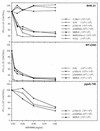Multiple virulence determinants of foot-and-mouth disease virus in cell culture
- PMID: 9658076
- PMCID: PMC109783
- DOI: 10.1128/JVI.72.8.6362-6372.1998
Multiple virulence determinants of foot-and-mouth disease virus in cell culture
Abstract
Hypervirulent variants of foot-and-mouth disease virus (FMDV) of serotype C arise upon serial cytolytic or persistent infections in cell culture. A specific mutation in the internal ribosome entry site of persistent FMDV was previously associated with enhanced translation initiation activity that could contribute to the hypervirulent phenotype for BHK-21 cells. Here we report that several hypervirulent FMDV variants arising upon serial cytolytic passage show an invariant internal ribosome entry site but have a number of mutations affecting structural and nonstructural viral proteins. The construction of chimeric type O-type C infectious transcripts has allowed the mapping of a major determinant of hypervirulence to the viral capsid. Tissue culture-adapted FMDV displayed enhanced affinity for heparin, but binding to cell surface heparan sulfate moieties was not required for expression of the hypervirulent phenotype in Chinese hamster ovary (CHO) cells. Virulence was identical or even higher for glycosaminoglycan-deficient CHO cells than for wild-type CHO cells. FMDV variants with decreased affinity for heparin were selected from a high-binding parental population and analyzed. Substitutions associated with decreased heparin binding were located at positions 173 of capsid protein VP3 and 144 of capsid protein VP1. These substitutions had a moderate effect on virulence for BHK-21 cells but completely abrogated infection of CHO cells. The comparative results with several FMDV isolates show that (i) increased affinity for heparin and alterations in cell tropism may be mediated by a number of independent sites on the viral capsid and (ii) the same capsid modifications may have different effects on different cell types.
Figures





References
-
- Charpentier N, Dávila M, Domingo E, Escarmís C. Long-term, large-population passage of aphthovirus can generate and amplify defective noninterfering particles deleted in the leader protease gene. Virology. 1996;223:10–18. - PubMed
-
- Costa Giomi M P, Bergmann I E, Scodeller E A, Augé de Mello P, Gómez I, La Torre J L. Heterogeneity of the polyribocytidylic acid tract in aphthoviruses: biochemical and biological studies of viruses carrying polyribocytidylic acid tracts of different lengths. J Virol. 1984;51:799–805. - PMC - PubMed
Publication types
MeSH terms
Substances
LinkOut - more resources
Full Text Sources
Other Literature Sources

